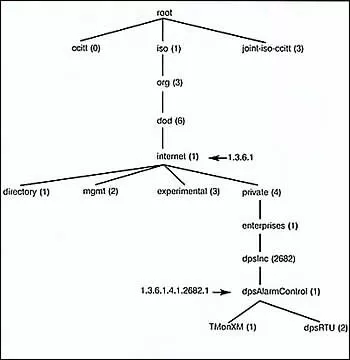Download our free SNMP White Paper. Featuring SNMP Expert Marshall DenHartog.
This guidebook has been created to give you the information you need to successfully implement SNMP-based alarm monitoring in your network.
1-800-693-0351
Have a specific question? Ask our team of expert engineers and get a specific answer!
Sign up for the next DPS Factory Training!

Whether you're new to our equipment or you've used it for years, DPS factory training is the best way to get more from your monitoring.
Reserve Your Seat TodayThe OID is a kind of address. It locates this particular element within the entire SNMP universe. The OID describes a tree structure, as shown in below, and each number separated by a decimal point represents a branch on that tree.

The first few numbers identify the domain of the organization that issued the OID, followed by numbers that identify objects within the domain. Imagine if your home address started with "Universe, Milky Way Galaxy ..." and ended with your house number. In a similar way, each OID begins at the root level of the OID domain and gradually becomes more specific.
Each element of the OID also has a human-readable text designation. From left to right, our sample OID reads:
1 (iso): The International Organization for Standardization, one of the two organizations that assign OID domains.
3 (org): An ISO-recognized organization.
6 (dod): U.S. Department of Defense, the agency originally responsible for the Internet.
1 (internet): Internet OID.
4 (private): Private organizations.
1 (enterprises): Business enterprises.
2682 (dpsInc): DPS Telecom.
1 (dpsAlarmControl): DPS alarm and control devices.
2 (dpsRTU): DPS remote telemetry unit.
102 (dpsRTUsumPClr): A Trap generated when all the alarm points on an RTU are clear.
When the SNMP Manager, a T/Mon in this case, requests the value ("state") of any object it is monitoring, it sends a message with that object's OID to its Management Information Base. The MIB will decode the address and attach a text description to it. This allows the SNMP Manager to present the value of the alarm condition with the identifying description of the labeled alarm.